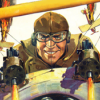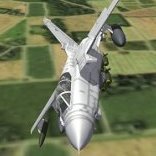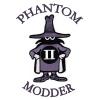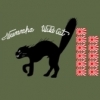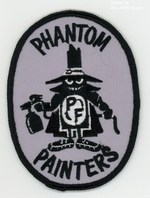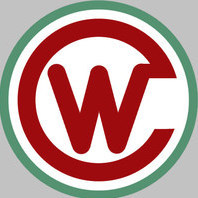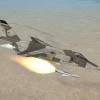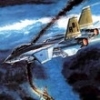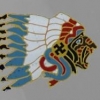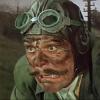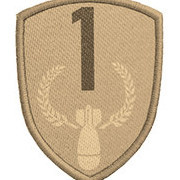Leaderboard
Popular Content
Showing most liked content on 01/08/2018 in Posts
-
6 points
-
6 points
-
4 pointsA good observation! For much of the war the Allies experienced a chronic shortage of machine guns, particularly light weight aircraft guns. This problem gradually went away during 1917 with new factories coming online - and the introduction of the SPAD 13. On the subject of synchronizers, there are all kinds of internet references that state N17s were built with Vickers guns mounted on the center line. Only problem with that, is the French Ministry of Munitions never authorized production of any rotary engine synchonizer other than the Alkan-Hamy! Or, if it did, the records have not survived 100 years of turmoil. Again, I suspect the confusion arises from the British inability to develop a reliable synchronizer until mid-1917! Per Woodman's Early Aircraft Armament, the Brits employed the following systems, only one of which was equal to the Fokker/Alkan-Hamy gears: Vickers-Challenger: Bristol Scout, Sopwith 1-1/2 Strutter, BE12, RE8 Scarff-Dybovsky: Sopwith 1-1/2 Strutter, Sopwith Pup Sopwith-Kauper: Sopwith aircraft (particularly Camel), despite flaws was closest the Brits came to a standardized gear until Constantinesco gear was introduced in 1917 Ross: Sopwith 1-1/2 Strutter ARISAD: Nieuport 20, early RE8 Armstrong-Whitworth: FK8 Constantinesco: When the Brits finally got their act together - a year after everyone else - they did it right. Beginning with DH4 in Spring of 1917, the excellent "CC" gear was to have replaced all earlier gears, but it proved impossible to modify all British aircraft in the real world. The British duplication of effort is remarkable, particularly when you consider that most of the gears were not as good as the German/French gears. The best the Brits could field before mid-1917 was 2,750 Sopwith-Kauper gears, despite a tendency for the guns to "run away" and shoot up the propeller - they also had a high rate of mechanical failure due to excessive wear.
-
3 points
-
3 pointsView File de Havilland Sea Venom FAW.21-22-ECM Sea Venom FAW.21 - Improved version, equivalent to Venom NF.3. 4,950 lbf (22.1 kN) Ghost 104 engine, AI Mk 21 (US APS-57) radar. 167 built. Sea Venom FAW.22 - More powerful (5,300 lbf (23.6 kN)) Ghost 105 engine, giving improved high-altitude performance. 39 new built. Sea Venom ECM.21-22 - Six FAW.21s modified from 1957 for ECM purposes. ECM.22Equivalent of ECM.21, based on FAW.22. No armament. In 1956 Sea Venoms, alongside RAF Venoms, took part in the Suez War which began on 31 October. They were from Nos. 809, 892, 893 Naval Air Squadrons based on the light fleet carrier HMS Albion and fleet carrier HMS Eagle. The Anglo-French invasion, codenamed Operation Musketeer, took place in response to the nationalisation of the Suez Canal by Egypt's leader, General Nasser. The air war began on the 31 October 1956 signalling the beginning of the Suez War. The Sea Venoms launched many sorties, bombing a variety of targets in Egypt in the process. By 1959, the Sea Venom began to be replaced in Royal Navy service by the de Havilland Sea Vixen, an aircraft that also had the distinctive twin-boom tail. The Sea Venom would be withdrawn from frontline service soon afterwards. The type continued to fly with second line FAA units until the last were withdrawn in 1970 WHAT's IN: 3 new planes 26 skins decals, weapons, pilots CREDITS: - Veltro2k model - Baffmeister FM - Spillone104 sound, inis tweakings, testings - Stary pit - Wrench original templates, hangar templates - paulopanz skins, decals, screens INSTALL: - put all in your mod folder OPTIONAL: - hangars 1024 x 726 Enjoy @paulopanz NOTE: an update for Suez '56 campaign pack is in the makings, not only Seavenoms, stay tuned! Submitter paulopanz Submitted 01/07/2018 Category Other
-
3 pointshere are all panel numbers and the markings for the F-15C and E , hope that is what you are looking for F-15C_E Panelnumbers & Markings.7z
-
2 pointsFor his outstanding work in moving the Strike Fighters community forward, and his contributions in modding, advice, skinning and general all-around good guy, has been awarded the title of Modder Congrats, brother! Welcome to the faternity! and, as always, the first round is on YOU!!
-
2 pointsHey guys, sorry for being late to the party, but as some of you know, I'm moving my living place half across Germany. On workdays I do my job and on weekends I have to get things done in the old flat 500km away. Just came home from a very busy weekend again. If all goes well, I'm finally done at the end of this month and I hope to get back to modding and skinning after that. The last weeks and months I hardly did anything useful regarding SF2, but few things that are on the way: - Update to the TA-4F-FastFACs - highres skins and some fakepilot-addons - Foreign TA-4 Skyhawks (Australia, Israel (with and without extended exhaust tube), New Zealand, Indonesia,...) - all Vietnam Skyhawks units and deployements (long term project) - early AD Skyraider templates - new TA-4 SKyhawk-model from scratch - since it's my first project (and done in Blender), I don't know if it ever leads to something useful, but we'll see. The fuselage is done at the moment. Thank you for this honor, my friends! And now Cheers!
-
2 points
-
1 pointAs some you know, I've been slowly working on converting Mytai's F-4B skins to newer, better SF2 standards. Mostly through using Sundowner's hi-rez template. Some of which was covered in this thread: But several questions have arisen. One, obviously answered with these sentences: But the primary one remains, as to "year operations". Since we have the ability to turn on skins at a certain date (the SF2 date switch in the texture set ini), do I 1) use the date date switch, which forces the game to use that as the primary skin from the start year selected, of 2) not use the date switch, and let the End User (tm) select the skin -and have to also select for all wingmen in the flights. Also, if anyone else is working on converting these 70-odd skins, DO LET ME KNOW! So work won't be duplicated and cause a waste of time!! So, let's hear what you all think...
-
1 pointOperation Combat Fox/ Operation Formation Star: On 23 January 1968 North Korean patrol boats supported by MiG-21 fighters captured the USS Pueblo northeast of the North Korean island of Ung-do. The seizure of the Pueblo led to President Lyndon Johnson ordering a show of force with a massive deployment of U.S. air and navy assets to Korea. The airlift and deployment of 200+ aircraft was code named Operation Combat Fox and the deployment of six aircraft carriers plus support vessels was code named Operation Formation Star. After further considering an appropriate response to the incident (including a nuclear strike), on Febuary 1, 1968, President Lyndon Johnson orders an aerial bombardment campaign against North Korean Military targets. The campaign has three objectives: 1) demonstrate U.S. resolve in the face of communist aggression; 2) weaken the Military infrastructure of North Korea and its future ability to threaten South Korea; 3) deliver a message to North Korea that the United States will respond to any aggression on the peninsula with massive force. In response to US air strikes North Korean forces have attacked across the DMZ, The Korean peninsula is once again actively at war.
-
1 pointFor those of you who dislike Steam, we've released Cold Waters and Atlantic Fleet on GOG.com at a discount. Go buy them if you haven't already. https://www.gog.com or click the images below for each respective title download page.
-
1 point
-
1 point
-
1 pointThe SPAD VII cames with FE2. Much better than Capun´s. The Tripe and Br XIV only at Capun so far.
-
1 pointIt must be added that machine gun shortage was the main reason why French planes had only 1 Machine Gun until the Spad 13
-
This post cannot be displayed because it is in a password protected forum. Enter Password
-
This post cannot be displayed because it is in a password protected forum. Enter Password
-
1 pointJup! The F-5A was Sophocles Project. He is still around, but haven´t heard anything from him since a long time...
-
1 point
-
1 pointgood job! but The location of some of the instruments also need to be adjusted.
-
1 point
-
1 point
-
1 pointTrying to add numbers to skin. If anyone has info on numbers and placement...sure would welcome the help.. Thanks, Pappy
-
1 point
-
1 pointAnd if so can it be uploaded to the SF1 Downloads section for other SF1 users to have the enjoyment of, assuming of course that it is SF1 version compatible. Thanks in advance for anyone taking the time to upload the Orion to the SF1 section.
-
1 point
-
1 point
-
1 pointI took Baffs idea and applied some changes to the old Wolf357 Bf-109F. I've gotten it to fly much better, considering how old it is! Let me do a little more testing and I'll upload a copy of the data ini for you folks to test.
-
1 point
-
1 point
-
1 pointThank you sir! This is a photo of the Nieuport-17 Replica. This aircraft was restored to the 100th anniversary of the Russian Air Force in 2012. http://vikond65.livejournal.com/2605.html
-
1 point
-
1 pointCrawford: Thanks for the shot. One reason new aircraft take so long, is the extensive research and development necessary. Thought you guys might enjoy reading some of our correspondence: VonS: Have now test flown the latest iteration of the Nieu. 17 c.1 and it flies well, also looks great. I also made some tweaks and created a separate DUX variant for the 17 c.1, slightly lower ceiling and stiffer control input/reaction on that one (attached below). Geezer: Your thorough attention to detail is commendable. I love it! Looks like the DUX N17 should be a separate release? Along those lines, what are your thoughts concerning Lewis gun armed N17s, as they were not the production standard but were a depot/field mod, primarily by the British. I dug out my definitive reference - Early Aircraft Armament (Woodman) - and it paints a rather complex picture about French and British aircraft armament. When war began, the French did not produce/use either the Vickers or Lewis gun and vainly attempted to use their Hotchkiss gun for aircraft use, but failed as it was too heavy and gas-operated. Because of its light weight, Britain and France then preferred the Lewis for aircraft use, and ignored the fact it's gas operation was not suitable for synchronization; they wasted months trying to develop a practical system. The most practical Lewis gear was developed by Sergent-Mecanicien Alkan in early 1916, but it suffered from a low rate of fire resulting from synchronizing engine rpm with a gas-operated gun. The British subsequently developed several synchronizer systems for the Vickers, all of which had minor flaws but were used operationally as nothing better was available. In mid-1917, the Constaninesco gear was introduced and was so successful it continued in use by the RAF until the introduction of monoplanes in the 1930s; it supplemented but never replaced the other gears at the front in WW1. Sergent-Mecanicien Alkan, cooperating with Ingenieur du Maritime Hamy, developed a copy of the Fokker gear and it became the standard French synchronizer for rotary engines. Marc Birkigt simultaneously developed a different gear for inline engines, sometimes called the "SPAD gear." The Alkan-Hamy synchronizer was standardized as the Systeme de Synchroization pour Vickers Type 1 (moteurs rotatifs) and was offset slightly starboard of center line because of the configuration of the cam follower, which transferred mechanical pulses from the spinning rotary engine. Eventually, France had to place large orders with British and American factories for Vickers and Lewis guns, resulting in shortages as the factories were already working at max capacity. Due to these shortages, it was not unusual for French, and sometimes British, aircraft to be delivered without armament. The two air forces then played "catch up" by installing armament at depot level, and sometimes at squadron level. This resulted in the many different installations on rotary-powered aircraft, primarily Nieuports and Sopwiths. There were seldom enough Vickers guns or Alkan synchronizers to equip all rotary powered aircraft built by France.
-
This post cannot be displayed because it is in a password protected forum. Enter Password
-
1 point
-
1 point
Important Information
By using this site, you agree to our Terms of Use, Privacy Policy, and We have placed cookies on your device to help make this website better. You can adjust your cookie settings, otherwise we'll assume you're okay to continue..

